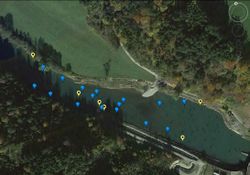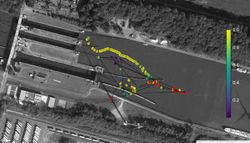Difference between revisions of "Acoustic telemetry"
Bendikhansen (talk | contribs) |
Bendikhansen (talk | contribs) |
||
| Line 1: | Line 1: | ||
=Quick summary= | =Quick summary= | ||
| + | [[file:telemetry_iller.jpg|thumb|250px|Figure 1: VPS array in the river Iller (Germany) covering a fish pass outflow downstream of a hydropower plant (Vemco 180 kHz system). Blue marks are hydrophones containing synchronisation tags and yellow marks are reference tags.]][[file:telemetry_albert.jpg|thumb|250px|Figure 2: example of a silver eel track at the Albert Canal (Belgium) using VPS at 69 kHz.]] | ||
Developed by: | Developed by: | ||
| Line 9: | Line 10: | ||
=Introduction= | =Introduction= | ||
| − | |||
Together with radio and PIT telemetry, acoustic telemetry is a biotelemetry technique that has been used on fish for over 60 years. The principle of acoustic telemetry consists of the communication between an emitting tag (fish) and a receiving device (hydrophone) by means of an acoustic signal to determine the location of the tag (fish). This location can provide useful information about migration, individual behaviour, habitat use, passage efficiency, predation, etc. Acoustic telemetry uses lower radio frequency signals (69-500 kHz) compared to radio telemetry (30-300 MHz), which both have advantages and disadvantages. A major drawback of acoustic compared to radio telemetry used to be the poor reading range in turbulent water systems. Recent developments countered this drawback by using higher frequency signals. Nowadays, also more challenging environments like noisy, shallow and reflective water systems are suitable for acoustic telemetry. This evolution also allows positioning many tagged animals with sub-meter accuracy at the same time. Another unique advantage of acoustic telemetry is its capability to be used in salt and deep water. These features make this technique suitable to conduct fish behaviour studies that are able to address multiple research questions, even for diadromous fish species. Besides a single registration of a fish (1D or presence/ absence), more and more research is done to gather fish tracks in 2D or even 3D at specific sites like migration obstacles, fish passes and hydropower stations (Figure 3). The principle of this precise positioning of fish is based on the difference in detection time of a tag that is positioned in between at least 3 receiving hydrophones. Depending on the producer of the tags and hydrophones, the acoustics work at different kHz ranges. When the producer is VEMCO, then the 2D/3D positioning system is called VPS and this works at either 69 kHz or 180 kHz. Initially, this VPS (Vemco Positioning System) was mainly used in big lakes using 69 kHz tags, but recently small-scale accurate fish tracking is possible using a higher 180 kHz frequency. The choice for one or the other frequency depends on the system studied and the study objectives. Typically, the VPS array is equipped with reference and synchronisation tags to monitor system performance and to correct for clock drift between different submerged hydrophones. Figure 1 and 2 show a VPS array conducted at the Fithydro case study of the river Iller (Altusried, Germany) and another one in the Albert Canal (Ham, Belgium). | Together with radio and PIT telemetry, acoustic telemetry is a biotelemetry technique that has been used on fish for over 60 years. The principle of acoustic telemetry consists of the communication between an emitting tag (fish) and a receiving device (hydrophone) by means of an acoustic signal to determine the location of the tag (fish). This location can provide useful information about migration, individual behaviour, habitat use, passage efficiency, predation, etc. Acoustic telemetry uses lower radio frequency signals (69-500 kHz) compared to radio telemetry (30-300 MHz), which both have advantages and disadvantages. A major drawback of acoustic compared to radio telemetry used to be the poor reading range in turbulent water systems. Recent developments countered this drawback by using higher frequency signals. Nowadays, also more challenging environments like noisy, shallow and reflective water systems are suitable for acoustic telemetry. This evolution also allows positioning many tagged animals with sub-meter accuracy at the same time. Another unique advantage of acoustic telemetry is its capability to be used in salt and deep water. These features make this technique suitable to conduct fish behaviour studies that are able to address multiple research questions, even for diadromous fish species. Besides a single registration of a fish (1D or presence/ absence), more and more research is done to gather fish tracks in 2D or even 3D at specific sites like migration obstacles, fish passes and hydropower stations (Figure 3). The principle of this precise positioning of fish is based on the difference in detection time of a tag that is positioned in between at least 3 receiving hydrophones. Depending on the producer of the tags and hydrophones, the acoustics work at different kHz ranges. When the producer is VEMCO, then the 2D/3D positioning system is called VPS and this works at either 69 kHz or 180 kHz. Initially, this VPS (Vemco Positioning System) was mainly used in big lakes using 69 kHz tags, but recently small-scale accurate fish tracking is possible using a higher 180 kHz frequency. The choice for one or the other frequency depends on the system studied and the study objectives. Typically, the VPS array is equipped with reference and synchronisation tags to monitor system performance and to correct for clock drift between different submerged hydrophones. Figure 1 and 2 show a VPS array conducted at the Fithydro case study of the river Iller (Altusried, Germany) and another one in the Albert Canal (Ham, Belgium). | ||
Revision as of 07:51, 17 June 2019
Contents
Quick summary
Developed by:
Date:
Type: Method
Suitable for the following [[::Category:Measures|measures]]:
Introduction
Together with radio and PIT telemetry, acoustic telemetry is a biotelemetry technique that has been used on fish for over 60 years. The principle of acoustic telemetry consists of the communication between an emitting tag (fish) and a receiving device (hydrophone) by means of an acoustic signal to determine the location of the tag (fish). This location can provide useful information about migration, individual behaviour, habitat use, passage efficiency, predation, etc. Acoustic telemetry uses lower radio frequency signals (69-500 kHz) compared to radio telemetry (30-300 MHz), which both have advantages and disadvantages. A major drawback of acoustic compared to radio telemetry used to be the poor reading range in turbulent water systems. Recent developments countered this drawback by using higher frequency signals. Nowadays, also more challenging environments like noisy, shallow and reflective water systems are suitable for acoustic telemetry. This evolution also allows positioning many tagged animals with sub-meter accuracy at the same time. Another unique advantage of acoustic telemetry is its capability to be used in salt and deep water. These features make this technique suitable to conduct fish behaviour studies that are able to address multiple research questions, even for diadromous fish species. Besides a single registration of a fish (1D or presence/ absence), more and more research is done to gather fish tracks in 2D or even 3D at specific sites like migration obstacles, fish passes and hydropower stations (Figure 3). The principle of this precise positioning of fish is based on the difference in detection time of a tag that is positioned in between at least 3 receiving hydrophones. Depending on the producer of the tags and hydrophones, the acoustics work at different kHz ranges. When the producer is VEMCO, then the 2D/3D positioning system is called VPS and this works at either 69 kHz or 180 kHz. Initially, this VPS (Vemco Positioning System) was mainly used in big lakes using 69 kHz tags, but recently small-scale accurate fish tracking is possible using a higher 180 kHz frequency. The choice for one or the other frequency depends on the system studied and the study objectives. Typically, the VPS array is equipped with reference and synchronisation tags to monitor system performance and to correct for clock drift between different submerged hydrophones. Figure 1 and 2 show a VPS array conducted at the Fithydro case study of the river Iller (Altusried, Germany) and another one in the Albert Canal (Ham, Belgium).
Application
The main goal of tagging with VIE is the visual recognition of individuals. This can be achieved with a unique code, depending on the number of animals, colours and tagging places available. Obtaining results is based on mark and recapture techniques, and usually as a complement of another tracking system. The main application is focused on temporary habitat use studies. In the case of fishways, tagging fish downstream, upstream and inside the fishway, and recapturing some of them, can provide information about their movements. In contrast to other tag devices smaller individuals (even less than five centimetres) can be tagged with VIE and the cost per tag is quite low (€ cents per tag per millilitre of product and day of tagging). However, about costs, it is necessary to also take into account the need for fish samples, or video recording devices that are required for the recaptures
Other information
More information about range size and species with links to research papers can be found here: https://www.nmt.us/versatile-vie/ There are other types of tags with similar characteristics and/or applications. For example: VI Alpha tags (https://www.nmt.us/vi-alpha/), Anchor tags (https://www.hallprint.com/), piercing tags (https://nationalband.com/fish-tags/).

